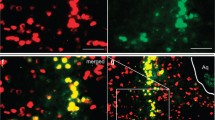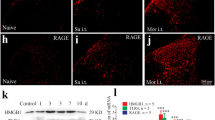Abstract
Tolerance to the chronic administration of opioids such as morphine reduces the utility of these drugs in pain management. Despite significant investigation, the precise cellular mechanisms underlying opioid tolerance and dependence remain elusive. It has been indicated that tolerance to the analgesic effect of morphine is associated with apoptosis in the central nervous system. The aim of this study was to examine the effects of the intracerebroventricular (icv) administration of minocycline (a second-generation tetracycline) on morphine-induced apoptosis in the cerebral cortex and lumbar spinal cord of rats after morphine-induced tolerance. Different groups of rats received either morphine (ip) and distilled water (icv) or morphine and different doses of minocycline (icv) or minocycline alone once per day. The terminal deoxynucleotidyl transferase-mediated dUTP nick-end labeling (TUNEL) method was used to analyze apoptosis. The anti-apoptotic factors, Bcl-2 and HSP 70 and the pro-apoptotic element caspase-3 were evaluated by immunoblotting. The results indicated that minocycline attenuated the number of apoptotic cells in both the cerebral cortex and lumbar spinal cord. Immunoblotting findings showed that the amounts of anti-apoptotic agents (Bcl-2 and HSP 70) were greater in the treatment groups than in the controls in both regions. Although minocycline did not change the level of caspase-3 at the doses used with morphine but the minocycline treated rats showed a significantly lower increase in caspase-3 activity than did in the control. In conclusion, minocycline decreased the number of TUNEL-positive cells and increased the amount of anti-apoptotic factors (Bcl-2 and HSP 70), but did not change the caspase-3 content.





Similar content being viewed by others
References
Bellmann K, Jaattela M, Wissing D, Burkart V, Kolb H (1996) Heat shock protein hsp70 overexpression confers resistance against nitric oxide. FEBS Lett 391:185–188
Boronat MA, Garcia-Fuster MJ, Garcia-Sevilla JA (2001) Chronic morphine induces up-regulation of the pro-apoptotic Fas receptor and down-regulation of the anti-apoptotic Bcl-2 oncoprotein in rat brain. Br J Pharmacol 134:1263–1270
Chen Q, Cui J, Zhang Y, Yu LC (2008) Prolonged morphine application modulates Bax and Hsp70 levels in primary rat neurons. Neurosci Lett 441:311–314
Cho KO, La HO, Cho YJ, Sung KW, Kim SY (2006) Minocycline attenuates white matter damage in a rat model of chronic cerebral hypoperfusion. J Neurosci Res 83:285–291
Choi Y, Kim HS, Shin KY, Kim EM, Kim M, Kim HS, Park CH, Jeong YH, Yoo J, Lee JP, Chang KA, Kim S, Suh YH (2007) Minocycline attenuates neuronal cell death and improves cognitive impairment in Alzheimer’s disease models. Neuropsychopharmacology 32:2393–2404
Domercq M, Matute C (2004) Neuroprotection by tetracyclines. Trends Pharmacol Sci 25:609–612
Gonzalez JC, Egea J, Del Carmen Godino M, Fernandez-Gomez FJ, Sanchez-Prieto J, Gandia L, Garcia AG, Jordan J, Hernandez-Guijo JM (2007) Neuroprotectant minocycline depresses glutamatergic neurotransmission and Ca(2+) signalling in hippocampal neurons. Eur J Neurosci 26:2481–2495
Gordon SA, Hoffman RA, Simmons RL, Ford HR (1997) Induction of heat shock protein 70 protects thymocytes against radiation-induced apoptosis. Arch Surg 132:1277–1282
Habibi-Asl B, Alimohammadi B, Charkhpour M, Hassanzadeh K (2009a) Evaluation the effects of systemic administration of minocycline and riluzole on tolerance to morphine analgesic effect in rat. Pharm Sci (J Fac Pharm, Tabriz Univ Med Sci) 15:205–212
Habibi-Asl B, Hassanzadeh K, Charkhpour M (2009b) Central administration of minocycline and riluzole prevents morphine-induced tolerance in rats. Anesth Analg 109:936–942
Hassanzadeh K, Habibi-asl B, Roshangar L, Nemati M, Ansarin M, Farajnia S (2010) Intracerebroventricular administration of riluzole prevents morphine-induced apoptosis in the rat lumbar spinal cord. Pharmacol Rep 62(4):664–673
Heo K, Cho YJ, Cho KJ, Kim HW, Kim HJ, Shin HY, Lee BI, Kim GW (2006) Minocycline inhibits caspase-dependent and -independent cell death pathways and is neuroprotective against hippocampal damage after treatment with kainic acid in mice. Neurosci Lett 398:195–200
Inturrisi CE (1997) Preclinical evidence for a role of glutamatergic systems in opioid tolerance and dependence. Semin Neurosci 9:110–119
Johnston IN, Milligan ED, Wieseler-Frank J, Frank MG, Zapata V, Campisi J, Langer S, Martin D, Green P, Fleshner M, Leinwand L, Maier SF, Watkins LR (2004) A role for proinflammatory cytokines and fractalkine in analgesia, tolerance, and subsequent pain facilitation induced by chronic intrathecal morphine. J Neurosci 24:7353–7565
Kraus RL, Pasieczny R, Lariosa-Willingham K, Turner MS, Jiang A, Trauger JW (2005) Antioxidant properties of minocycline: neuroprotection in an oxidative stress assay and direct radical-scavenging activity. J Neurochem 94:819–827
Li CY, Lee JS, Ko YG, Kim JI, Seo JS (2000) Heat shock protein 70 inhibits apoptosis downstream of cytochrome c release and upstream of caspase-3 activation. J Biol Chem 275:25665–25671
Mao J (1999) NMDA and opioid receptors: their interactions in antinociception, tolerance and neuroplasticity. Brain Res Brain Res Rev 30:289–304
Mao J, Price DD, Zhu J, Lu J, Mayer DJ (1997) The inhibition of nitric oxide-activated poly(ADP-ribose) synthetase attenuates transsynaptic alteration of spinal cord dorsal horn neurons and neuropathic pain in the rat. Pain 72:355–366
Mao J, Sung B, Ji RR, Lim G (2002) Neuronal apoptosis associated with morphine tolerance: evidence for an opioid-induced neurotoxic mechanism. J Neurosci 22:7650–7661
Mika J, Wawrzczak-Bargiela A, Osikowicz M, Makuch W, Przewlocka B (2009) Attenuation of morphine tolerance by minocycline and pentoxifylline in naive and neuropathic mice. Brain Behav Immun 23:75–84
Morimoto N, Shimazawa M, Yamashima T, Nagai H, Hara H (2005) Minocycline inhibits oxidative stress and decreases in vitro and in vivo ischemic neuronal damage. Brain Res 1044:8–15
Mosser DD, Caron AW, Bourget L, Denis-Larose C, Massie B (1997) Role of the human heat shock protein hsp70 in protection against stress-induced apoptosis. Mol Cell Biol 17:5317–5327
Paxinos G, Watson C (1998) The rat brain in stereotaxic coordinates. Academic Press, London
Popovic N, Schubart A, Goetz BD, Zhang SC, Linington C, Duncan ID (2002) Inhibition of autoimmune encephalomyelitis by a tetracycline. Ann Neurol 51:215–223
Rothman SM, Olney JW (1986) Glutamate and the pathophysiology of hypoxic—ischemic brain damage. Ann Neurol 19:105–111
Sadowski T, Steinmeyer J (2001) Minocycline inhibits the production of inducible nitric oxide synthase in articular chondrocytes. J Rheumatol 28:336–340
Salinska E, Danysz W, Lazarewicz JW (2005) The role of excitotoxicity in neurodegeneration. Folia Neuropathol 43:322–339
Sanchez Mejia RO, Ona VO, Li M, Friedlander RM (2001) Minocycline reduces traumatic brain injury-mediated caspase-1 activation, tissue damage, and neurological dysfunction. Neurosurgery 48:1393–1399 (discussion 1399–1401)
Singhal PC, Sharma P, Kapasi AA, Reddy K, Franki N, Gibbons N (1998) Morphine enhances macrophage apoptosis. J Immunol 160:1886–1893
Singhal PC, Kapasi AA, Reddy K, Franki N, Gibbons N, Ding G (1999) Morphine promotes apoptosis in Jurkat cells. J Leukoc Biol 66:650–658
Stirling DP, Khodarahmi K, Liu J, McPhail LT, McBride CB, Steeves JD, Ramer MS, Tetzlaff W (2004) Minocycline treatment reduces delayed oligodendrocyte death, attenuates axonal dieback, and improves functional outcome after spinal cord injury. J Neurosci 24:2182–2190
Stirling DP, Koochesfahani KM, Steeves JD, Tetzlaff W (2005) Minocycline as a neuroprotective agent. Neuroscientist 11:308–322
Tikka TM, Koistinaho JE (2001) Minocycline provides neuroprotection against N-methyl-d-aspartate neurotoxicity by inhibiting microglia. J Immunol 166:7527–7533
Wang X, Zhu S, Drozda M, Zhang W, Stavrovskaya IG, Cattaneo E, Ferrante RJ, Kristal BS, Friedlander RM (2003) Minocycline inhibits caspase-independent and -dependent mitochondrial cell death pathways in models of Huntington’s disease. Proc Natl Acad Sci USA 100:10483–10487
Whiteside GT, Munglani R (2001) Cell death in the superficial dorsal horn in a model of neuropathic pain. J Neurosci Res 64:168–173
Wu DC, Jackson-Lewis V, Vila M, Tieu K, Teismann P, Vadseth C, Choi DK, Ischiropoulos H, Przedborski S (2002) Blockade of microglial activation is neuroprotective in the 1-methyl-4-phenyl-1,2,3,6-tetrahydropyridine mouse model of Parkinson disease. J Neurosci 22:1763–1771
Yrjanheikki J, Tikka T, Keinanen R, Goldsteins G, Chan PH, Koistinaho J (1999) A tetracycline derivative, minocycline, reduces inflammation and protects against focal cerebral ischemia with a wide therapeutic window. Proc Natl Acad Sci USA 96:13496–13500
Zhu S, Stavrovskaya IG, Drozda M, Kim BY, Ona V, Li M, Sarang S, Liu AS, Hartley DM, Wu DC, Gullans S, Ferrante RJ, Przedborski S et al (2002) Minocycline inhibits cytochrome c release and delays progression of amyotrophic lateral sclerosis in mice. Nature 417:74–78
Acknowledgments
This research was supported by the Drug Applied Research Center of Tabriz University of Medical Sciences grant.
Author information
Authors and Affiliations
Corresponding author
Rights and permissions
About this article
Cite this article
Hassanzadeh, K., Habibi-asl, B., Farajnia, S. et al. Minocycline Prevents Morphine-Induced Apoptosis in Rat Cerebral Cortex and Lumbar Spinal Cord: A Possible Mechanism for Attenuating Morphine Tolerance. Neurotox Res 19, 649–659 (2011). https://doi.org/10.1007/s12640-010-9212-0
Received:
Revised:
Accepted:
Published:
Issue Date:
DOI: https://doi.org/10.1007/s12640-010-9212-0




